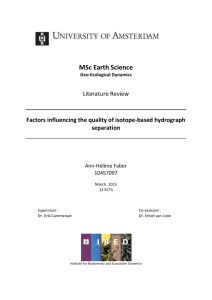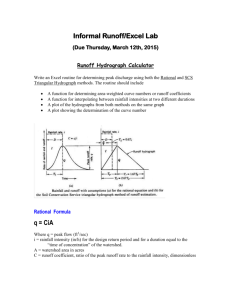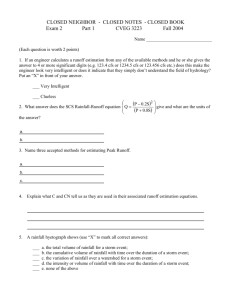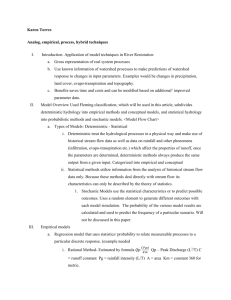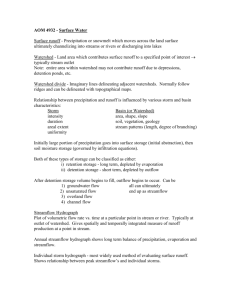a. components of runoff
advertisement
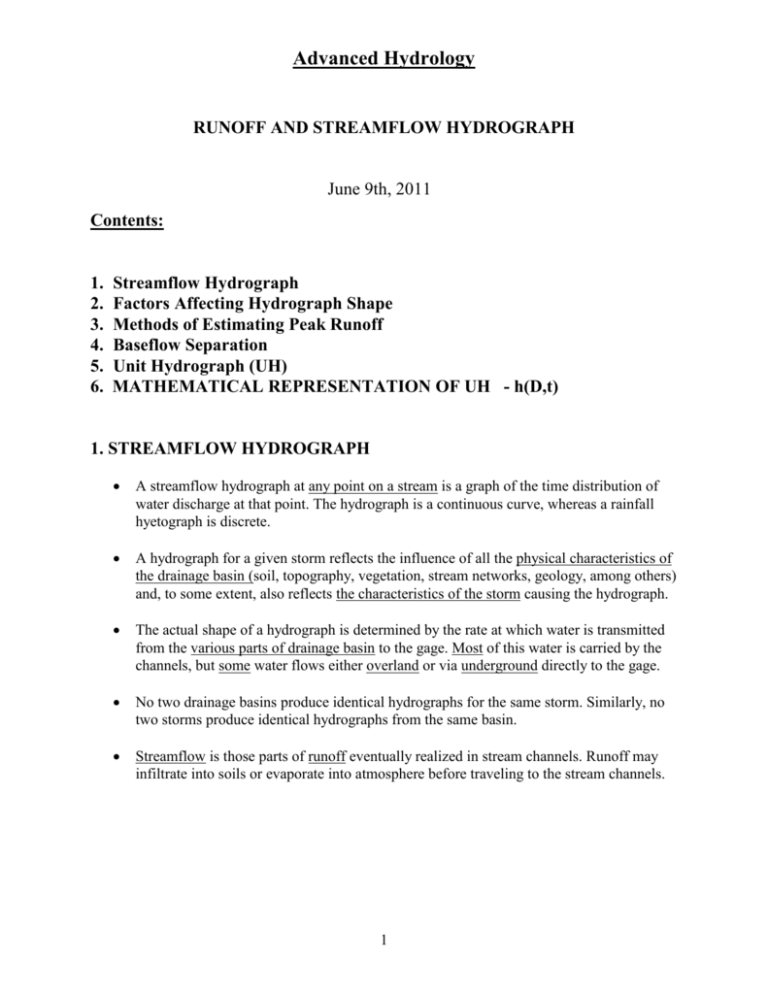
Advanced Hydrology RUNOFF AND STREAMFLOW HYDROGRAPH June 9th, 2011 Contents: 1. 2. 3. 4. 5. 6. Streamflow Hydrograph Factors Affecting Hydrograph Shape Methods of Estimating Peak Runoff Baseflow Separation Unit Hydrograph (UH) MATHEMATICAL REPRESENTATION OF UH - h(D,t) 1. STREAMFLOW HYDROGRAPH A streamflow hydrograph at any point on a stream is a graph of the time distribution of water discharge at that point. The hydrograph is a continuous curve, whereas a rainfall hyetograph is discrete. A hydrograph for a given storm reflects the influence of all the physical characteristics of the drainage basin (soil, topography, vegetation, stream networks, geology, among others) and, to some extent, also reflects the characteristics of the storm causing the hydrograph. The actual shape of a hydrograph is determined by the rate at which water is transmitted from the various parts of drainage basin to the gage. Most of this water is carried by the channels, but some water flows either overland or via underground directly to the gage. No two drainage basins produce identical hydrographs for the same storm. Similarly, no two storms produce identical hydrographs from the same basin. Streamflow is those parts of runoff eventually realized in stream channels. Runoff may infiltrate into soils or evaporate into atmosphere before traveling to the stream channels. 1 A. COMPONENTS OF RUNOFF SURFACE RUNOFF (= OVERLAND FLOW) – Fast component GROUNDWATER RUNOFF – Slow component including base flow (never intercept with topography) and spring INTERFLOW (THROUGHFLOW) – Intermediate Horizontal flow occurred in the unsaturated zone, e.g. via macro-pore flow B. ELEMENTS OF HYDROGRAPH Rising limb (concentration curve) The rising limb extends from the time of the beginning of surface runoff to the first inflexion point on the hydrograph. It depends upon storm and catchment characteristics. Crest segment Crest segment refers to the part of the hydrograph between the two inflexion points (one on the rising segment and the other on the recession segment). The peak occurs in this segment. Recession limb (depletion curve) Recession limb (or called receding limb) refers to the remaining part of the hydrograph which may or may not reduce to zero. It represents the withdrawal of water from storage after (approximately) excess rainfall has ceased. The shape of the recession curve depends on the catchment characteristics. The recession curve can be represented by an exponentially decaying type equation of the form Qt = Q0 e-Kt where Qt Q0 K - discharge at time 't' - initial discharge (at t = 0) - recession constant This equation plots as a straight line on semi-log scale: ln(Qt) = ln (Q0) - K t 2 3 C. HYDROGRAPH TIME CHARACTERISTICS Time to Peak – the time elapsed from the beginning of the rising limb (surface runoff) to the peak discharge Time of Concentration – the time required for a drop of water falling on the most remote part of the drainage basin to reach the basin outlet or gage. – It includes the time required for all portions of the drainage basin to contribute runoff to the hydrograph, therefore it represents the maximum discharge that can occur from a given storm intensity over the drainage basin (with its duration larger than the time of concentration). Lag Time – the elapsed time between the center of mass of effective rainfall and the center of mass of the direct runoff hydrograph. – Assume uniform effective rainfall over the entire basin – Due to the difficulty in determining the center of mass of the direct-runoff hydrograph, sometimes “lag time” is also defined as the elapsed time between the center of mass of the effective rainfall and the peak of the hydrograph. 2. FACTORS AFFECTING THE HYDROGRAPH SHAPE RAINFALL CHARACTERISTICS – Rainfall characteristics predominate in determining the shape of the rising segment of the hydrograph. The main climatic factors are Temporal Variability of Rainfall (i.e, intensity, intermittency, and duration) The intensity governs the time to peak and the peak value whereas the duration governs the time base of the hydrograph. Spatial Distribution of Rainfall in the catchment Depending upon where the high intensity occurs, the base length of the hydrograph may increase or decrease. For example, if the high intensity rainfall occurs near the outlet, the time base will be short. In comparison, if the high intensity rainfall occurs at the far end of the catchment, the time base would be relatively longer. 4 Direction of storm movement The direction of storm movement tends to increase or decrease the peak value by decreasing or increasing the time base of the hydrograph depending upon whether the storm is moving downstream or upstream. Type of precipitation If the intensity of rainfall excess is high, the hydrograph would be rapidly rising. In contrast, intermittent rainfall tends to give rather flat, multi-peak hydrographs. DRAINAGE BASIN CHARACTERISTICS Catchment area and shape - Increase in the catchment area tends to smooth the fluctuations of hydrograph Stream network Shape of main stream and valleys Depression storage - reduces the peak SOIL, GEOLOGY, AND LANDS USE Soil and geological factors govern the flow of sub-surface runoff and therefore mainly affect the recession curve. Most changes in land use, like urbanization, farming, forest removal, and building roads, all will increase surface runoff. 3. METHODS OF ESTIMATING PEAK RUNOFF Rational formula method (Empirical) First introduced by Mulvaney, an Irish Engineer in 1851. In the USA, it is called Kuichling formula (1889) In the UK it is called Lloyd-Davis formula (1906) Qp = CIA where Qp - peak runoff C - runoff coefficient (0 < C < 1) I - rainfall intensity of a storm whose duration is greater than or equal to the time of concentration of the catchment A - catchment area 5 When Qp is expressed in m3/s; I in mm/hr; A in km2, Qp = 0.278CIA The formula assumes that the rainfall intensity is uniform over the entire basin throughout the duration of the storm. Time of concentration - The time required for a particle of water to move from the furthest point in the catchment to its outlet. There are several empirical equations to estimate it. Kirpich (1940) equation tc = 0.0195 L0.77 S-0.385 where tc - time of concentration (minutes) L - maximum length of travel (meters) S - slope = (H/L) where H is the difference in elevation between the furthest point in the catchment and the outlet. The time of concentration can also be expressed as a sum of the time of entry te and a time of travel tt as follows: tc = te + tt Mockus (1957) equation te = tL / 0.6 where te - time of entry (overland flow concentration time or time of overland flow) tL - lag time Ragan and Duru (1972) equation 0.6 6 . 917 ( nL ) te I 0.4 S 0.3 where min. n - Manning's roughness coefficient (= 0.2 for paved areas and 0.5 for grass) Time of travel is simply the length of channel divided by the velocity. There are other equations of the form Qp AN 6 Runoff coefficient - Depends upon the nature of the surface the slope the surface storage the degree of saturation the rainfall intensity. For non-homogeneous areas, a weighted runoff coefficient can be obtained by the following equation: Cw = A1C1 A1 PEAK Discharge as a significant design parameter Example Referring to Fig. 2a, A1 = 500 ha; A2 = 600 ha; A3= 800 ha and A4 = 200 ha. The rainfall distribution is as shown in the Figure. The runoff coefficients are 0 - 1 hr, 1 - 2 hr, 2 - 3 hr, 3 - 4 hr, C = 0.5 C = 0.7 C = 0.8 C = 0.85 Assuming that the rainfall and runoff coefficients are average values for the duration of each hour, determine the resulting direct runoff hydrograph. Time (hr) Contribution from each area Q = CIA Area A1 Area A2 Area A3 Area A4 Rainfall (mm) 1 2 3 4 5 0-1 1-2 2-3 3-4 4-5 5-6 6-7 15 30 30 15 10.4 29.2 33.3 17.7 12.5 35.0 40.0 20.8 16.67 46.67 53.3 27.78 Computations for columns 3 - 7 are done as follows: 7 6 41.67 116.67 133.33 69.44 Total Runoff 7 10.4 41.7 85.0 146.0 191.0 161.0 69.4 For A1, hour 1, hour 2, hour 3, hour 4, Q1 = 0.5 x 15 x 500 (mm.ha/hr) Q2 = 0.7 x 30 x 500 Q3 = 0.8 x 30 x 500 Q4 = 0.85 x 15 x 500 = 10.4 m3/sec = 29.2 = 33.3 = 17.7 For A2, hour 1, hour 2, hour 3, hour 4, Q1 = 0.5 x 15 x 600 (mm.ha/hr) Q2 = 0.7 x 30 x 600 (mm.ha/hr) Q3 = 0.8 x 30 x 600 (mm.ha/hr) Q4 = 0.85 x 15 x 600 (mm.ha/hr) = 12.5 m3/sec = 35.0 m3/sec = 40.0 m3/sec = 20.8 m3/sec (For the second hour discharges are delayed by one hour) Similarly, for A3 and A4, the corresponding discharges are computed and are summed up to obtain the total effect. 4. BASE FLOW SEPARATION - All methods are approximate STRAIGHT LINE METHOD The point A represents the beginning of the surface runoff. Point B represents the end of surface runoff. The latter is obtained by a semi-log plot of total runoff vs. time and determining the point of intersection of the two segments (which should be straight lines with different slopes). Point B is transferred from the semi-log plot to the linear plot. FIXED BASE LENGTH SEPARATION The point A is the same as in the last method. The point B is determined on the assumption that the surface runoff always ends after a fixed interval of time T, measured after the peak of the hydrograph. The time T is expressed as empirical functions of the catchment area A, in forms such as T = An where n is an empirical parameter. VARIABLE SLOPE SEPARATION First, the existing recession curve is extended to a point in time just below the peak (AB). Point D represents the end of surface runoff and is obtained by a semi-log plot. 8 The semi-log part is extended backwards (DC) to a point C which is just below the second point of inflexion (on the recession curve) of the hydrograph. The method of joining BC is rather arbitrary. MASTER DEPLETION CURVE METHOD The procedure is based on the recession data from a number of hydrographs, which will cover a wide range of discharges and seasons. The recession curves are plotted using semi-log scale on tracing paper with one graph for each event. On a separate master sheet, also using semi-log scale, the recession parts are transferred from the individual sheets starting from the graph having the lowest magnitude such that all the recession parts fall upon the straight segment of the master depletion curve. An empirical equation can then be fitted to the master depletion curve. 9 5. UNIT HYDROGRAPH (UH) Basic Definitions Effective Rainfall (ER) - ER is defined as that rainfall that produces direct (surface) runoff. Rainfall excess - Equal to effective rainfall. Direct runoff (Surface Runoff) - Direct runoff is the runoff component directly resulting from rainfall excess. It is the difference between the total runoff and base flow. (1) The Unit hydrograph method is one of the basic tools in hydrological computations. It was originally developed by L.K. Sherman in 1932. (2) A unit hydrograph (UH) of a watershed is defined as the direct runoff hydrograph (DRH) resulting from one unit (1 inch or 1cm) of effective rainfall (ER) occurring uniformly over the watershed at a uniform rate during a specified period of time. The specified period of time is called the unit storm duration or simply unit duration. The assumption of “ER occurring uniformly over the watershed” is more suitable for small watershed. Rainfall storms that produce intense rainfall usually do not extend over large areas. The assumption of “at a uniform rate” is more suitable for large watersheds. (3) The specified period of time, i.e., unit storm duration, is not necessarily equal to unity. It can be any finite duration up to the time of concentration. It is the period for which the UH is determined; that is, as soon as this period changes, so does the UH for a watershed. (4) Thus, there can be as many UHs for a watershed as many period of rainfall, for example, 1hour UH, 6-hour UH, or 12-hour UH. The 1, 6, 12 here are not the duration for which the UH occurs, but it is the duration of the ER for which the UH is defined. (5) Because effective rainfall is assumed to occur uniformly, its duration defines its intensity. (6) When ER is 1 unit / hr, DRH and 1-hour UH are numerically identical. (7) Notice that the dimension of UH is either L2 1 or . T T 10 Basic Postulates: The UH theory assumes that the rainfall excess - direct runoff process is (1) Linear - DRH is derived from the Effective Rainfall Hyetograph (ERH) by a liner operation; that is, the principles of superposition and proportionality. (2) Time-invariant – ignore the influence of antecedent moisture condition of a catchment; allow the translation in time. 1. For a given basin, the duration of surface runoff is constant for all uniform-intensity storms of the same length, regardless of differences in the total volume of surface runoff. However, for two uniform-intensity storms of the same length, the rates of surface runoff are in the same proportion to the total volume of surface runoff. (The principle of proportionality) 2. The time distribution of surface runoff from a given storm period is independent of concurrent runoff from antecedent storm periods. (The principle of superposition) 3. The ER is uniformly distributed within its duration. This means that the rainfall intensity is uniform throughout the watershed during the time rain falls. This steady rainfall intensity must occur even if the unit time is 1 hour or 2 hours or whatever. 4.Hydrologic losses must be uniform over the entire watershed. The principles of proportionality and superposition define linearity of the UH theory. They lead to very useful practical applications of the unit hydrograph concept. For example, a hydrograph of discharge resulting from a series of rainfall excesses may be constructed by summing up the hydrographs due to each single unit of rainfall excess. They also imply that the time base of direct runoff hydrographs resulting from rainfall excesses of same unit duration is the same regardless of the intensity. The above assumptions are all based on the assumption that the watershed is linear. Remember in mind, in fact, all watersheds in nature are non-linear; some are more non-linear and some less. 11 12 6. MATHEMATICAL REPRESENTATION OF UH - h(D,t) Let the ERH (effective rainfall hyetograph) of D-hour duration be denoted as: I (t ) I , 0 t D 0, t D (D is the duration of ER) The resulting DRH (direct runoff hydrograph) is: Q(t ) h( D, t ) I (t ) D h( D, t ) ID when ID is 1, the DRH and UH are numerically the same. In the right side of the figure below, let each pulse be of duration D hours, intensity I1 , I 2 , I 3 , the DRH Q1 (t ), Q2 (t ), Q3 (t ) . If the D-hour UH is h( D, t ) . Then the DRH is: Q(t ) Q1 (t ) Q2 (t ) Q3 (t ) 13 Notice that since Q2 (t ) does not start until t = D, and Q3 (t ) does not start until t = 2D. Therefore, by using D-hr UH h( D, t ) , each individual DRH can be expressed as Q1 (t ) h( D, t ) I1 D Q2 (t ) h( D, t D) I 2 D; Q2 (t ) 0, t D Q3 (t ) h( D, t 2 D) I 3 D; Q3 (t ) 0, t D Q(t ) h( D, t ) I1 D h( D, t D) I 2 D h( D, t 2 D) I 3 D j1 hD, t j 1DI j D 3 Q(t ) j 1 hD, t j 1DI j D n Q(t ) j 1 hD, t j 1DI j D t or D. INSTANTANEOUS UNIT HYDROGRAPH (IUH) When the duration of ER is infinitely small, the UH theory approaches the reality. The limiting case is D 0 : IUH (t ) h(t ) lim h( D, t ) h(0, t ) D0 (t ) lim I (t , D) D Dirac Delta function D0 (t )dt 1; (t ) 0, for t 0 - Q(t ) 0 h(t ) I ( )d ; h( ) 0, for 0 t or by simple change of variables Q(t ) 0 h( ) I (t )d t convolutio nal integral with 0 h( s )ds 1; lim h(t ) 0; t h(t ) 0, for any t 0 14 15


